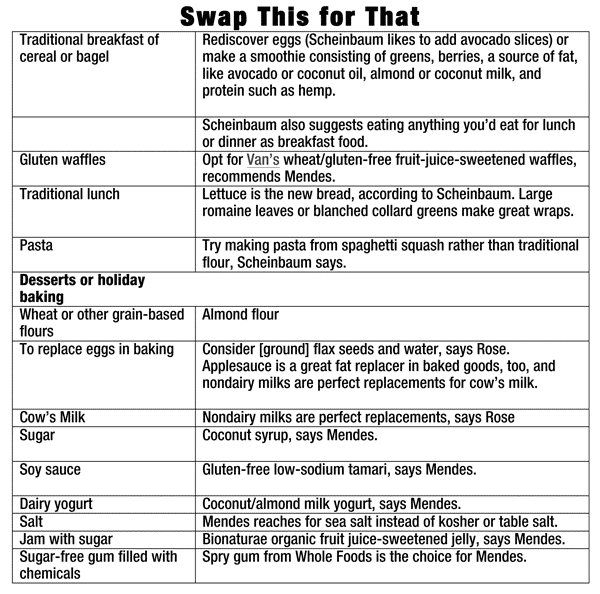By Megy Karydes
“There are many ways to kick-start healthy eating,” says Kim Gracen, executive chef, Heartland Café in Chicago’s Rogers Park neighborhood. Hint: It doesn’t start with the food we eat.
“When we think of nourishment, most will correlate that to nutrition,” says Gracen. “However, we humans eat for many reasons, only one of which is for nutrition.” Gracen acknowledges that some of us eat because we’re stressed, happy or as a reward for certain behaviors.
Rather than concentrating on what we’re eating, she feels that the first thing we need to do to develop healthy eating habits is to identify why we are eating. “If eating [were] not combined with emotions and memories, it would be easy to obtain optimal health,” she says. “Start questioning your food choices without judgment. Identify why you choose to eat what you eat. Some reasons may surprise you. So start questioning why, then move to what.”
Dena Mendes, director of Dena’s Healthy U in Highland Park and author of A Survivor’s Guide to Kicking Cancer’s Ass (Hay House), feels we owe it to ourselves and our families to not only eat healthier fare but to demand cleaner food from our grocery stores to our restaurants.
“An anti-inflammatory, low acidic way of life is ideal,” Mendes says. High on her list of recommendations is consuming more greens, good quality oils/fats, seaweed for minerals and better-quality animal proteins. “Eating more consciously and choosing the healthier version of foods that we love with less wheat/gluten, dairy, sugar, caffeine and diet/sugar-free foods not only makes us physically healthier, it actually improves our moods, our sleep habits [and] energy levels as well as how great our skin, hair and nails can look!” she adds.
How do we make that transition to healthier eating? Are there easy ways to swap out things we love to eat with healthier options? A few minor changes will go a long way, our experts say.
As a general rule, if Gracen can’t pronounce the ingredients in a packaged item, she doesn’t eat it. Sandra Scheinbaum, PhD, takes it one step further and tries to combat myths through her practice in Highland Park, Feed Your Mind Wellness. One of those myths, she says, is that a grain-based diet is healthy.
“When clients tell me that they eat a healthy diet and I ask them to describe what they’ve eaten in the last three days, cereal or a bagel for breakfast, followed by a sandwich for lunch and pasta for dinner are typical answers,” Scheinbaum says. “They’re shocked to hear that they’re consuming the sugar diet.”
Sugar is a big culprit, Mendes admits, but an easy one to swap out for healthier alternatives. (See the Swap This for That box below).
When Gracen was developing Heartland’s new menu, she wanted to create mashed potatoes with robust flavor while giving additional reasons to indulge in the comforting carb delight. How did she create a healthy dish without sacrificing taste?
“We roast yellow potatoes and cauliflower with vegetable stock and finish it with chopped fresh kale,” she carefully fills us in on her secret. “This gives us that
mashed-potato fix while adding some great nutrients and complementary flavors.”
Incorporating vegetables, especially green leafy ones whenever you can, is something Gracen highly recommends to makes dishes healthier in general. “Sneak them in,” she says. “Vegetable stock has great flavor and is a good way to flavor food without adding fat and extra calories.”
For those who want to transition to a more meatless diet, Marla Rose from Berwyn often fields questions from friends interested in her vegan lifestyle. Their goal is to eat healthier but without sacrificing the flavor profiles they find in meat or dairy. “I think that when people stop eating animal products, what they miss (other than being full to the point that is uncomfortable later) is umami, that savory flavor that rounds out dishes, also known as the ‘fifth taste,’” says Rose. “I don’t think that soy and seitan/wheat gluten really replace that.”
In those cases, Rose recommends to people who are missing meat to boost umami by incorporating things like tamari or soy sauce, olives, caramelized onions, mushrooms, seaweed and miso.
Like Gracen, Rose suggests getting creative to achieve those flavor profiles your body craves while keeping it healthy.
But how about bacon? Can we make bacon healthier?
“There is no substitution for bacon, period,” Gracen declares. “Many have tried to duplicate the flavor and texture with no avail. If you must eat bacon, eat a strip or two. Moderate. Decide that for every strip of bacon you decide to consume, you will drink one more glass of water, and a serving of leafy greens. Diets based on what you cannot have do not work. Eat the bacon if you must; just be smart about it.”











